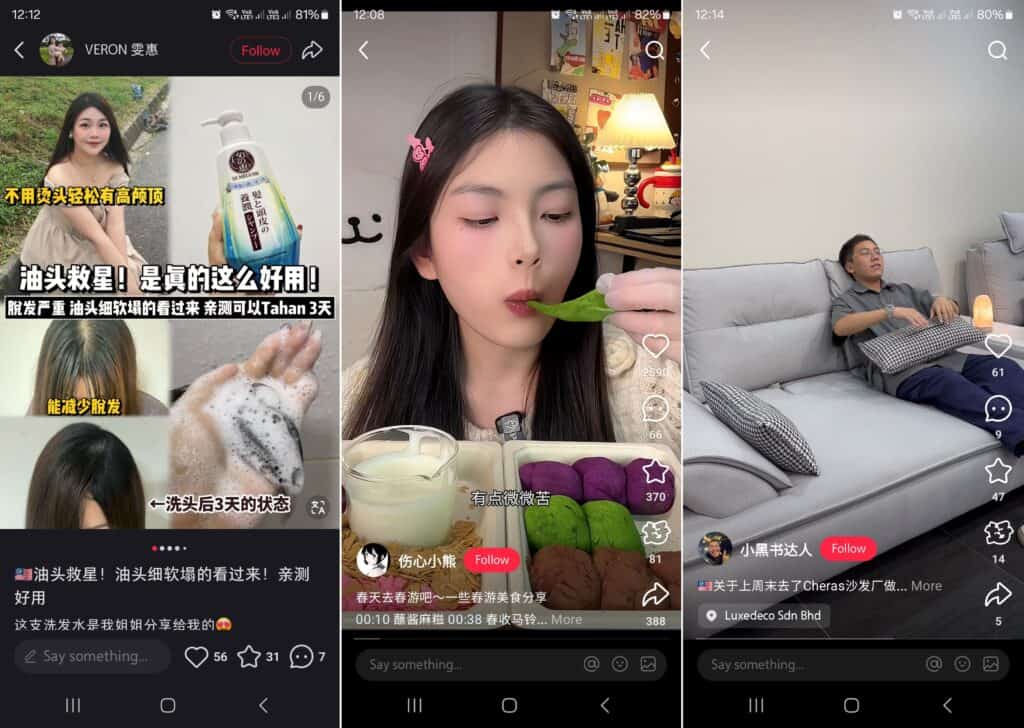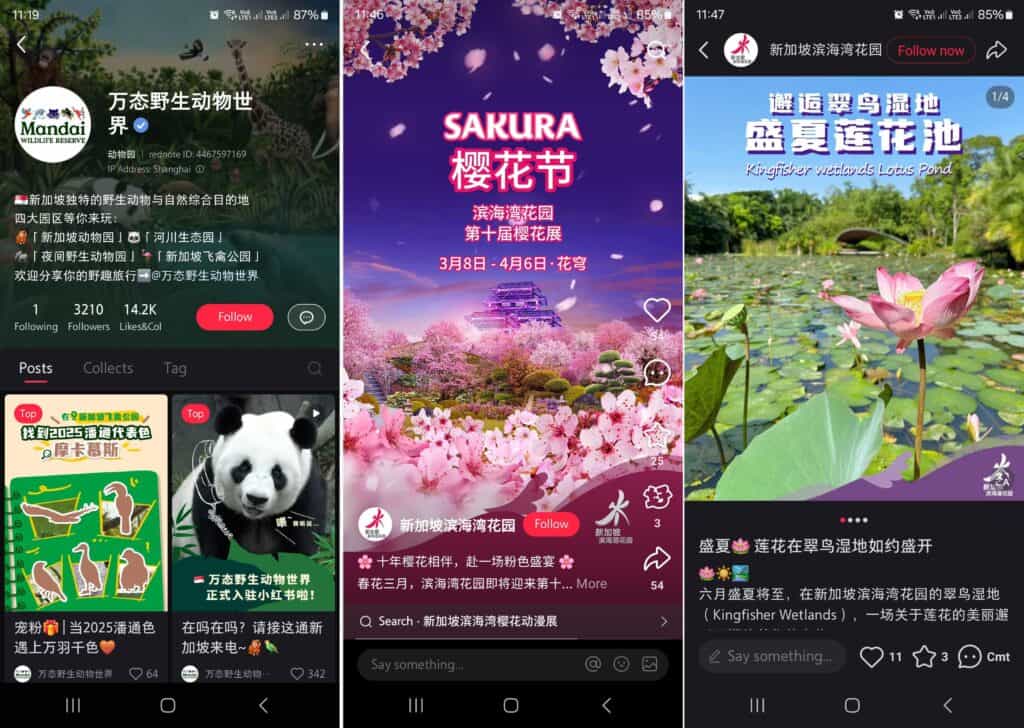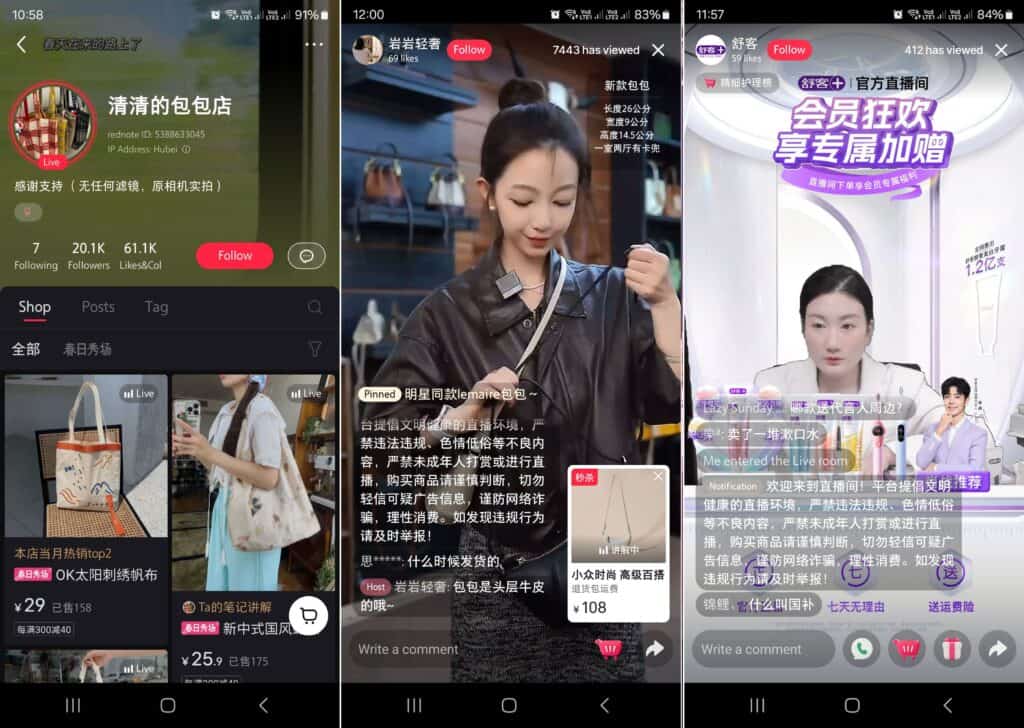Last updated on October 17th, 2025 at 02:01 am
I’ve been on Xiaohongshu (RedNote, Little Red Book, or RED) for five years now, exploring its mix of user-generated content and e-commerce. (I’ve actually shared insights about this platform and China marketing a few times here—feel free to check them out!) While many are familiar with Xiaohongshu’s core features, there are plenty of lesser-known aspects that might surprise you. After half a decade on the platform, here’s what I’ve learned.
1. Authenticity Rules the Algorithm
Xiaohongshu has a strict content moderation system to maintain trust and credibility, using a combination of AI and human moderators to detect and filter out misleading or inauthentic content.
Unlike other platforms like TikTok or Instagram, Xiaohongshu’s algorithm favours posts that appear genuine and authentic. For example, it likes “收藏” (Save) over “点赞” (Like) because it interprets saving as a strong intent signal, indicating that users find the content valuable and want to revisit it later. This affects content ranking and discoverability.
Posts that violate guidelines—such as fake reviews, inappropriate material, or overly promotional and scripted content—are often deprioritised or quickly removed.
This focus on authenticity has made it a trusted platform for user-generated reviews and recommendations, often referred to as the “Chinese Instagram” but with a stronger emphasis on trust and utility.
What You Should Do:
Focus on creating authentic, experience-based content that feels natural and relatable rather than overly polished or sales-driven. Share personal stories, genuine product experiences, or lifestyle tips that provide clear value to your audience. Encourage actions like “收藏” (Save) by offering practical, memorable takeaways that people want to revisit. Maintain transparency, avoid exaggerated claims, and align your tone with Xiaohongshu’s community-driven culture to improve both visibility and long-term trust.
2. A Post’s Success Is Determined in the First 24 Hours
Xiaohongshu uses a tiered content distribution system. New posts are first shown to a small test audience, and if engagement (saves, comments, shares) is high within the first 24 hours, the post gets pushed to a larger audience. This makes timing and immediate engagement crucial. To maximise reach, plan your content schedule accordingly and post at optimal times.
What You Should Do:
Post strategically at times when your target audience is most active to increase the chances of immediate engagement. Focus on creating content that encourages interaction—such as saves, shares, and meaningful comments—within the first 24 hours. Experiment with different posting times, track performance, and adjust your schedule to identify optimal windows for reaching a larger audience through Xiaohongshu’s tiered distribution system.
3. Limits External Traffic – Even From WeChat
Xiaohongshu discourages external links and off-platform traffic redirection, including links to WeChat official accounts. Even when links are allowed, they often receive lower visibility. Brands should prioritise in-platform content strategies rather than relying on Xiaohongshu to drive traffic elsewhere.
What You Should Do:
Build your content strategy around keeping users engaged within Xiaohongshu rather than directing them off-platform. Focus on providing valuable, complete information in your posts so users don’t feel the need to leave the app. Use storytelling, tutorials, and authentic reviews to build trust and brand recognition natively. Treat Xiaohongshu as a branding and awareness channel first, rather than a direct traffic driver, to maximise visibility and long-term growth.
4. KOCs (Key Opinion Consumers) Are More Influential Than KOLs (Key Opinion Leaders)
While KOLs are influential on many platforms, Xiaohongshu places a higher value on KOCs. These are everyday users who share detailed, honest reviews and experiences.
Brands often collaborate with KOCs for grassroots marketing campaigns, as their content is perceived as more relatable and trustworthy.
Many brands assume that big influencers (KOLs) drive the best results, but Xiaohongshu’s micro-influencers (KOCs) often generate higher engagement and conversion rates due to their perceived authenticity. Some campaigns achieve better ROI by working with 50 smaller KOLs rather than one large KOL.
What You Should Do:
Prioritise collaborations with KOCs (everyday users) over relying solely on high-profile KOLs. Seek out micro-influencers who produce authentic, detailed, and relatable content, as their recommendations resonate more strongly with Xiaohongshu’s community. Structure campaigns around multiple smaller partnerships to build grassroots credibility and higher engagement, rather than concentrating your budget on a single large influencer. This approach often leads to stronger trust, better conversion rates, and improved ROI.

5. SEO Matters More Than Hashtags
While hashtags help with visibility, keyword placement in captions and comments is even more critical. Xiaohongshu functions as a search engine, and users frequently look up product reviews and recommendations. Posts with long-tail keywords (e.g., “best sunscreen for oily skin in Singapore”) tend to perform well.
What You Should Do:
Optimise your captions with natural-sounding, long-tail keywords that reflect how users search for recommendations and reviews on Xiaohongshu. Instead of relying only on hashtags, weave specific product features, locations, or scenarios into your text to improve discoverability. Monitor trending search terms and incorporate them strategically into your posts and even your comment replies to increase search visibility and attract targeted audiences.
6. Brand Accounts Are at a Disadvantage Compared to Personal Accounts
After spending 2–3 hours on Xiaohongshu every night for more than five years, I’ve come to realise just how much the platform prioritises content from personal accounts over brand accounts. Unlike traditional social media platforms where businesses can thrive with official brand pages, Xiaohongshu favours authentic, user-generated content, which is why personal accounts are more valued, and their content more often seen in the feed.
To adapt, many brands now create ‘persona accounts’—profiles designed to look like regular users rather than corporate entities. These accounts share experiences, product recommendations, and lifestyle content in a way that feels natural and relatable, making them more likely to gain traction on the platform.
What You Should Do:
Build persona accounts that appear like authentic personal users to naturally engage with Xiaohongshu’s community. Share genuine experiences, product recommendations, and lifestyle content through these accounts to increase your chances of visibility and engagement. Avoid overly corporate tones and focus on storytelling that feels relatable and trustworthy, helping your content blend seamlessly into users’ feeds.
What You Should Do:
Consider building persona accounts that resemble genuine users rather than relying solely on official brand pages. Share lifestyle-oriented, experience-driven content through these accounts to blend seamlessly into Xiaohongshu’s community culture. Focus on relatability and storytelling, ensuring your posts feel personal instead of corporate, as this increases visibility and engagement within the feed.
7. Drives Buying Decisions, But Not Transactions
Xiaohongshu allows users to purchase products directly through the app, but most of the time, many users still use the platform primarily for research before buying products on other e-commerce platforms like Taobao or JD.com.
What You Should Do:
Focus on providing detailed, trustworthy product information and honest reviews to support users in their research journey. Use Xiaohongshu to build awareness and educate potential customers rather than pushing for immediate purchases within the app. Complement your Xiaohongshu presence with strong e-commerce strategies on external platforms to capture conversions after users complete their research.
8. Xiaohongshu’s Expanding Influence: Men & Gen Z
(a) Rising Popularity Among Men
While Xiaohongshu is predominantly female-centric and has been for many years, there has been a noticeable increase in male users in recent years. Men are increasingly using the platform for content related to fitness, travel, technology, and even fashion.
This shift presents new opportunities for brands targeting male audiences.
(b) Growing Influence on Gen Z
Xiaohongshu is increasingly popular among Gen Z users, who value its community-driven content and focus on lifestyle trends. The platform is a key space for discovering new trends, from niche beauty products to viral travel destinations.
Brands targeting Gen Z often use Xiaohongshu to launch campaigns that feel organic and community-focused.
What You Should Do:
Adapt your content strategy to embrace the growing diversity of Xiaohongshu’s audience by including topics and products that appeal to male users who would be interested in your products and/or services. Create targeted content that resonates with this emerging demographic to capture their interest authentically. Additionally, prioritise authentic, trend-driven campaigns that engage Gen Z users by tapping into community values and lifestyle trends they care about. Use storytelling and interactive content to build a genuine connection with both male and Gen Z audiences, leveraging Xiaohongshu’s strength as a platform for discovery and influence.
9. Niche Communities and Subcultures
Beyond mainstream topics like makeup and beauty, Xiaohongshu hosts niche communities and subcultures focused on specific interests, such as vintage fashion, sustainable living, and even pet care. These communities are highly engaged and offer opportunities for targeted marketing.
Expansion into Local Services and Travel
Besides that, Xiaohongshu has recently become a go-to platform for travel recommendations and local service reviews. Users share detailed guides, itineraries, and tips for destinations both in China and abroad. As a result, many tourism boards and hospitality brands seeking to attract Chinese travellers have embraced the platform over the past five years.

What You Should Do:
Identify and engage with Xiaohongshu’s niche communities relevant to your industry by creating content that speaks directly to their specific interests and needs. Focus on providing authentic, valuable information that resonates with these engaged audiences to build trust and meaningful connections. Tailor your marketing approach to address the unique preferences of each community, leveraging Xiaohongshu’s platform strengths to increase your brand’s visibility and relevance across diverse user groups.
10. International Expansion Efforts
After Trump warned of a possible TikTok ban, many foreign users began creating accounts on Xiaohongshu, exploring it as an alternative social platform. This surge in interest highlighted Xiaohongshu’s potential beyond China, especially among content creators and businesses looking to engage with Chinese consumers.
While Xiaohongshu primarily caters to the Chinese market, it has been gradually testing international expansion. The platform has introduced multilingual versions, instant translation features, and is actively exploring ways to attract non-Chinese users, particularly in Southeast Asia.
What You Should Do:
Consider Xiaohongshu not only as a gateway to the Chinese market but also as a growing international platform, especially for reaching Southeast Asian audiences and Chinese-speaking users in other countries like Singapore, Malaysia, Taiwan and Hong Kong. Leverage its multilingual features and create content that appeals across cultures while staying authentic to Xiaohongshu’s community values. Monitor the platform’s evolving expansion efforts and position your brand early to benefit from increased international exposure and cross-border engagement opportunities.
11. Collaboration with Douyin
Xiaohongshu and Douyin (China’s version of TikTok) often work hand in hand in marketing campaigns. While Douyin excels at short-form video content, Xiaohongshu provides in-depth reviews and detailed guides, offering a more comprehensive user journey.
Recently, more brands have started creating accounts on both platforms, using Douyin for dynamic, engaging videos while leveraging Xiaohongshu for deeper storytelling and product insights. This dual-platform approach helps them better reach and engage their audience.
What You Should Do:
Adopt a dual-platform marketing strategy by combining Xiaohongshu’s strength in detailed, authentic content with Douyin’s dynamic short-form videos. Use Douyin to capture attention with engaging visuals and quick messages, then guide interested users to Xiaohongshu for in-depth reviews, tutorials, and storytelling that build trust and inform purchase decisions. Coordinating content across both platforms creates a seamless user journey, maximising audience reach and engagement.
12. Livestreaming Is Underutilised but Highly Effective
Unlike Douyin, Xiaohongshu’s livestream feature is not widely used by brands, making it an untapped opportunity. Livestreams tend to attract highly engaged, niche audiences who trust the platform’s recommendation culture. If you’re already using this format on other platforms, consider incorporating it into your Xiaohongshu strategy as well.

What You Should Do:
Explore Xiaohongshu’s livestream feature as a relatively untapped channel to reach highly engaged and niche audiences. If livestreaming is part of your marketing on other platforms, adapt your content to fit Xiaohongshu’s authentic and recommendation-driven culture. Use livestreams to showcase products in real time, answer questions, and build deeper trust with viewers, capitalizing on this emerging opportunity before it becomes more competitive.
Conclusion
Xiaohongshu is more than just a social media platform—it’s a powerful tool for building trust and driving consumer decisions. Its focus on authenticity, combined with its e-commerce capabilities, makes it a unique and influential player in the Chinese digital landscape. Brands looking to succeed on Xiaohongshu should prioritise genuine engagement and leverage the platform’s community-driven nature.
Get Started Here!
The Chinese market is full of opportunities, but breaking into it through social media can be challenging. With over 5 years of hands-on experience on Xiaohongshu, I know what works—and what doesn’t. Whether you’re looking to grow brand awareness, attract Chinese consumers, or refine your Xiaohongshu strategy, I can help. Let’s talk! Reach me at 65-9622-8824 or email bei@beithoven.com to get started.
Want to unlock the full potential of this Chinese social media giant? Dive into this article for key strategies!
Singapore brands, don’t miss this—here’s how you can tap into Xiaohongshu for success!
Bei is a bilingual (English/Chinese) content and social media strategist based in Singapore, with over 20 years of marketing experience. Her work focuses on visual storytelling, AI art, content creation and optimisation, social media strategy, and China marketing.

